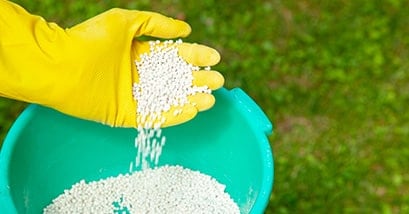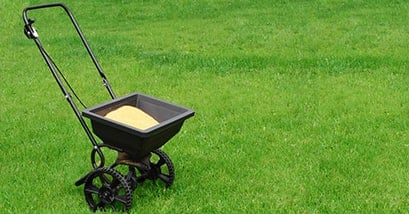Fertilizer

At Barefoot Lawn Care, we are committed to creating and maintaining the healthiest lawns possible for every single one of our customers. While there will always going to be ongoing lawn maintenance and treatments to supplement the initial success of a lawn program, the real star of the show is fertilizer.
We all know that it can help plants grow bigger, taller, and stronger. But what you may not have known is that an ongoing fertilizer treatment (or even a one-time treatment) for your lawn can have long-lasting benefits beyond the month post-treatment.
When should my lawn be fertilized?

This is a trick question–it all depends on the kind of grass you have in your yard. Believe it or not, there are different growing seasons for different kinds of grasses, so there is no “one-size-fits-all” fertilizer program. As such, at Barefoot Lawn Care, we work hard to create unique programs based entirely on your lawn, your needs, and your preferences for products, processes and final products.
In general, once we identify what kind of grass is in your yard, we will fertilize your lawn at the beginning of the grass’s growing season. This helps with overall root growth and health. So, if you have a warm-season grass, we will come to your home to fertilize from March through August to help grow a strong lawn that stays green through the summer. If you have cool-season grasses, there will be two applications of fertilizer: the first in September-November and then the second in February or March as the last strength-boost before the grass’s growing season slows down.
Fertilizer FAQs
How Often Should I Fertilize My Lawn?
Most lawns only require fertilizer three to four times a year to keep the grass green and healthy. However, the climate you live in and the type of grass you have may require fertilizing up to four to five times a year. A good rule of thumb is to only apply fertilizer during the seasons when your grass is growing the most. For warm season grasses, that would be during the spring and summer. For cool season grasses, that would be spring and fall.
How Do I Fertilize My Lawn?
When it comes time to fertilize your lawn, make sure you have the right fertilizer. Each turf type requires a special balanced fertilizer of nitrogen, phosphorus, and potassium. With the right fertilizer in hand, start by spreading the fertilizer around the perimeter of your lawn before filling in the middle. Then spread more by criss-crossing across your lawn. Also, take care to walk at a steady pace to ensure an even distribution of fertilizer.
When Do I Fertilize New Sod?
Wait to fertilize your new sod for about 4-6 weeks after it has been laid. During this time, the sod will take root and adjust to your lawn’s conditions. Look for signs of new growth before fertilizing, as you don’t want to damage the sod before it has had a chance to acclimate to your yard. This means if you installed your sod during the winter season, you should not fertilize until green grass has started to appear in the springtime.
When Is The Best Time To Fertilize My Lawn?
The best time to fertilize your lawn is when your grass is growing the most. For cool-season grasses like fescue, fertilize in the spring & fall is the best time. For warm-season grasses like Bermuda, centipede, zoysia or St. augustine, fertilize in the spring or early summer to prepare for their intensive summertime growth.
What Does Fertilizer Do?
Fertilizer provides additional nutrients for plants and grasses to supplement the food they produce themselves. Typically, fertilizer is composed of nitrogen, phosphorus and potassium. These nutrients are key to the healthy, ongoing growth of your lawn or garden and encourage faster growth.
What Does Fertilizer Do For Grass?
In general, fertilizer encourages faster, healthier growth in greenery. Fertilized grass is more likely to thicken and develop stronger roots, preventing lawn erosion during heavy rainstorms or other weather conditions.
When Do I Fertilize My Lawn In The Fall?
Fertilizing in the fall encourages winter growth of cool-season grasses, so it’s important to fertilize before the first freeze. Typically, a mid-October fertilizing gives your grass enough time to take in the nutrients needed for growing and enduring winter conditions before the weather turns. Cooler fall mornings also produce dew, which helps your lawn absorb the fertilizer.
When Do I Fertilize My Lawn In The Spring?
Your lawn should be ready for fertilizer by late spring when the grass is actively growing and needs additional nutritive fuel. Waiting until late spring ensures that the fertilizer is used for leaf growth and does not detract from grass root development, the focus of the grass’s energy in early spring. Grasses that leaf before their roots are developed are likely to erode and leave your lawn patchy.
Can I Over-Fertilize My Lawn?
Applying too much fertilizer to your lawn can damage or kill your plants and grasses and release harmful pollutants into the environment. Fertilizing too often over-saturates your lawn with nitrogen, which can lead to yellow or brown grass. Avoid over-fertilizing your lawn by providing fertilizer treatment once or twice a year, during the spring and fall.
Call us today for all of your lawn fertilizing needs
If you are looking for a consistently healthy and green lawn this year, don’t hesitate to call the experts at Barefoot Lawn Care to get your personalized lawn care plan started. No task is too much for us, as we can handle any job you need completed. We service the greater Triangle area, working in Apex, Cary, Garner, Clayton, Fuquay-Varina, Holly Springs, Johnston County, Wake County, Wake Forest and the surrounding areas. Give us a call to discuss fertilizer for your residential or commercial property at (919) 934-3554.